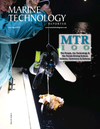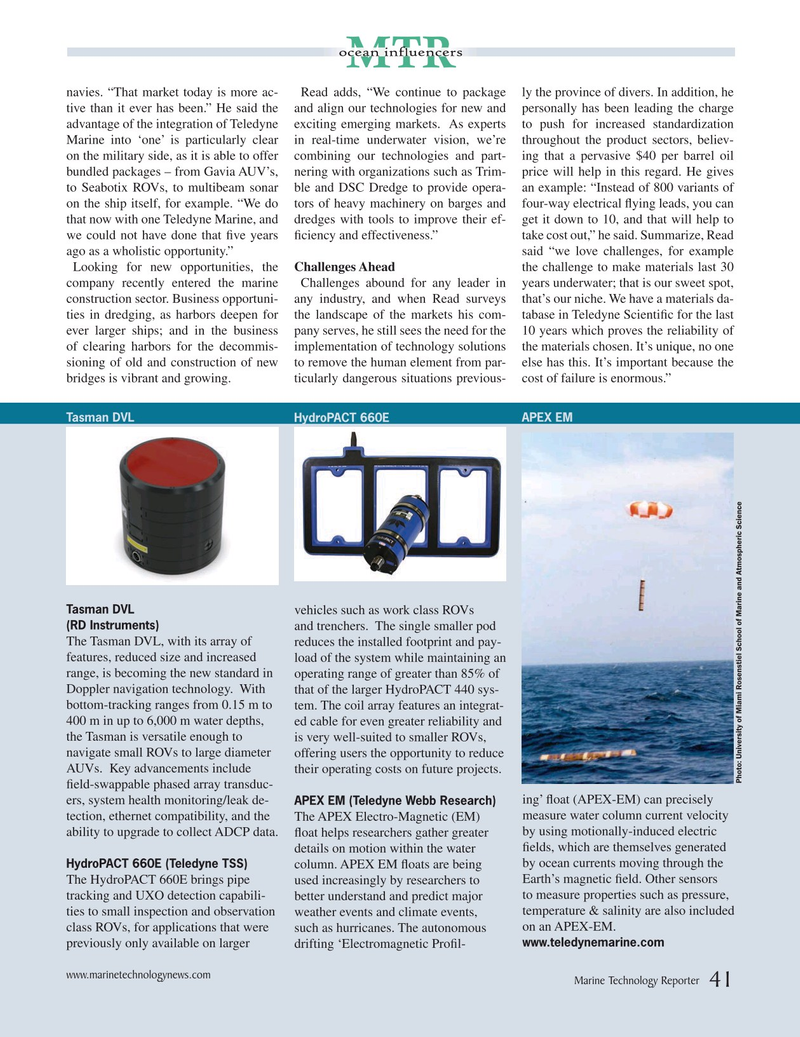
Page 41: of Marine Technology Magazine (July 2020)
Read this page in Pdf, Flash or Html5 edition of July 2020 Marine Technology Magazine
ocean inf uencersl
MTRMTR navies. “That market today is more ac- Read adds, “We continue to package ly the province of divers. In addition, he tive than it ever has been.” He said the and align our technologies for new and personally has been leading the charge advantage of the integration of Teledyne exciting emerging markets. As experts to push for increased standardization
Marine into ‘one’ is particularly clear in real-time underwater vision, we’re throughout the product sectors, believ- on the military side, as it is able to offer combining our technologies and part- ing that a pervasive $40 per barrel oil bundled packages – from Gavia AUV’s, nering with organizations such as Trim- price will help in this regard. He gives to Seabotix ROVs, to multibeam sonar ble and DSC Dredge to provide opera- an example: “Instead of 800 variants of on the ship itself, for example. “We do tors of heavy machinery on barges and four-way electrical ? ying leads, you can that now with one Teledyne Marine, and dredges with tools to improve their ef- get it down to 10, and that will help to we could not have done that ? ve years ? ciency and effectiveness.” take cost out,” he said. Summarize, Read ago as a wholistic opportunity.” said “we love challenges, for example
Looking for new opportunities, the Challenges Ahead the challenge to make materials last 30 company recently entered the marine Challenges abound for any leader in years underwater; that is our sweet spot, construction sector. Business opportuni- any industry, and when Read surveys that’s our niche. We have a materials da- ties in dredging, as harbors deepen for the landscape of the markets his com- tabase in Teledyne Scienti? c for the last ever larger ships; and in the business pany serves, he still sees the need for the 10 years which proves the reliability of of clearing harbors for the decommis- implementation of technology solutions the materials chosen. It’s unique, no one sioning of old and construction of new to remove the human element from par- else has this. It’s important because the bridges is vibrant and growing. ticularly dangerous situations previous- cost of failure is enormous.”
Tasman DVL HydroPACT 660E APEX EM
Tasman DVL vehicles such as work class ROVs (RD Instruments) and trenchers. The single smaller pod
The Tasman DVL, with its array of reduces the installed footprint and pay- features, reduced size and increased load of the system while maintaining an range, is becoming the new standard in operating range of greater than 85% of
Doppler navigation technology. With that of the larger HydroPACT 440 sys- bottom-tracking ranges from 0.15 m to tem. The coil array features an integrat- 400 m in up to 6,000 m water depths, ed cable for even greater reliability and the Tasman is versatile enough to is very well-suited to smaller ROVs, navigate small ROVs to large diameter offering users the opportunity to reduce
AUVs. Key advancements include their operating costs on future projects.
Photo: University of Miami Rosenstiel School of Marine and Atmospheric Science ? eld-swappable phased array transduc- ers, system health monitoring/leak de- ing’ ? oat (APEX-EM) can precisely
APEX EM (Teledyne Webb Research) tection, ethernet compatibility, and the The APEX Electro-Magnetic (EM) measure water column current velocity ability to upgrade to collect ADCP data. ? oat helps researchers gather greater by using motionally-induced electric details on motion within the water ? elds, which are themselves generated
HydroPACT 660E (Teledyne TSS) column. APEX EM ? oats are being by ocean currents moving through the
The HydroPACT 660E brings pipe used increasingly by researchers to Earth’s magnetic ? eld. Other sensors tracking and UXO detection capabili- better understand and predict major to measure properties such as pressure, temperature & salinity are also included ties to small inspection and observation weather events and climate events, class ROVs, for applications that were such as hurricanes. The autonomous on an APEX-EM. www.teledynemarine.com previously only available on larger drifting ‘Electromagnetic Pro? l- www.marinetechnologynews.com
Marine Technology Reporter 41
MTR #6 (34-49).indd 41 8/12/2020 5:25:02 PM

 40
40

 42
42
